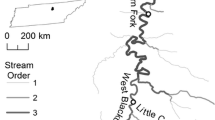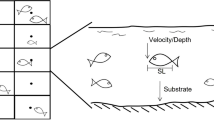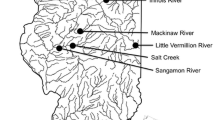Abstract
We investigated relationships between morphological attributes and mesohabitat use in populations of Cottus carolinae. Field studies revealed significant differences between Ozark and prairie stream mesohabitats where populations of C. carolinae occurred. Features of the mesohabitat that were characteristic of each stream type correlated with intra- and inter-specific differences in morphological attributes of Cottus. The morphology of Cottus occurring in the deeper, slower, and siltier prairie stream exhibited larger head width and depth, body width and depth, and caudal peduncle width while those occurring in a shallower, faster flowing Ozark stream had longer pelvic fins, larger eyes, and deeper caudal peduncles. Each population had a morphology tailored to optimize its performance in a specific habitat. Results of laboratory based performance studies using a variable flow chamber revealed that critical current velocities (CCV) of live and preserved specimens were weakly associated with distinct combinations of morphological traits. Specimens with higher CCV measurements typically had longer pelvic fins, larger eyes, and deeper caudal fins (Ozark morphology). Those with lower CCVs had larger head width and depth, body width and depth, and caudal peduncle width (prairie morphology) in studies using cobble as the substrate. Differences in flow regimes between prairie and Ozark streams may generate specific niches for specific morphotypes, and current velocity may exert selective pressure on morphology.
Similar content being viewed by others
References
Allan JD (1995) Physical factors of importance to the biota. In: Allan JD (ed) Stream ecology, structure and function of running waters. Kluwer Academic Publishers, Doredrecht, p 53
Burr BM, Mayden RL (1992) Phylogenetics and North American freshwater fishes. In: Mayden RL (ed) Systematics, historical ecology, and North American freshwater fishes. Stanford University Press, Stanford, pp18–76
Burr BM, Adams GL, Krejca JK, Paul RJ, Warren ML Jr (2001) Troglomorphic sculpins of the Cottus carolinae species group in Perry County, Missouri: distribution, external morphology, and conservation status. Environ Biol Fish 62:279–296
Douglas ME, Matthews WJ (1992) Does morphology predict ecology? Hypothesis testing within a freshwater stream fish assemblage. Oikos 65:213–224
Facey DE, Grossman GD (1990) The metabolic cost of maintaining position for four North American stream fishes: effects of season and velocity. Physiol Zool 63:757–776
Guill JM, Hood CS, Heins DC (2003) Body shape variation within and among three species of darters (Perciformes: Percidae). Ecol Freshw Fish 12:134–140
Hood CS, Heins DC (2000) Ontogeny and allometry of body shape in the blacktail shiner, Cyprinella venusta. Copeia 2000:270–275
Huckins CJF (1997) Functional linkages among morphology, feeding performance, diet, and competitive ability in molluscivorous sunfish. Ecology 78:2401–2414
Imre I., McLaughlin RL, Noakes DLG (2002) Phenotypic plasticity in brook charr: changes in caudal fin induced by water flow. J Fish Biol 61:1171–1181
Kingsolver JG, Pfennig DW, Servedio MR (2002) Migration, local adaptation and the evolution of plasticity. Trends Ecol Evol 17:540–541
Kinziger AP, Wood RM (2003) Molecular systematics of the polytypic species Cottus hypselurus (Teleostei: Cottidae). Copeia 2003:624–627
Koehl MAR (1996) When does morphology matter? Annu Rev Ecol Syst 27:50–542
Matheson RE Jr, Brooks GR Jr (1983) Habitat segregation between Cottus bairdi and Cottus girardi: an example of complex inter- and intra-specific resource partitioning. Am Midl Nat 110:165–176
Matthews WJ (1985) Critical current speeds and microhabitats of the benthic fishes Percina roanoka and Etheostoma flabellare. Environ Biol Fish 12:303–308
Miner BG, Sultan SE, Morgan SG, Padilla DK, Relyea RA (2005) Ecological consequences of phenotypic plasticity. Trends Ecol Evol 20:687–692
Peres-Neto PR, Magnan P (2004) The influence of swimming demand on phenotypic plasticity and morphological integration: a comparison of two polymorphic charr species. Oecologia 140:36–45
Pettersson LB, Hedenström A (2000) Energetics, cost reduction and functional consequences of fish morphology. Proc R Soc Lond B 267:759–764
Pflieger WL (1997) Ozark faunal region. In: Smith P (ed) The fishes of Missouri. Missouri Department of Conservation, Jefferson City, MO, pp 4–5
Piersma T, Drent J (2003) Phenotypic flexibility and the evolution of organismal design. Trends Ecol Evol 18:228–233
Piet GJ (1998) Ecomorphology of a size-structured tropical freshwater fish community. Environ Biol Fish 51:67–86
Pigliucci M (2005) Evolution of phenotypic plasticity: where are we going now? Trends Ecol Evol 20:481–486
Thomerson JE (1968) The fishes of Piasa Creek, West Central Illinois. Trans Ill State Acad Sci 1:70–79
Vogel S (1994) Velocity gradients and boundary layers. In: Vogel S (ed) Life in moving fluids, the physical biology of flow. Princeton University Press, Princeton, pp 127–140
Wainwright PC (1996) Ecological explanation through functional morphology: the feeding biology of sunfishes. Ecology 77:1336–1343
Webb PW, Gerstner CL, Minton ST (1996) Station-holding by the Mottled Sculpin, Cottus bairdi (Teleostei: Cottidae), and other fishes. Copeia 1996:488–493
West-Eberhard MJ (1989) Phenotypic plasticity and the origins of diversity. Annu Rev Ecol Syst 20:249–278
Acknowledgements
We thank the Illinois State Academy of Science and Southern Illinois University Edwardsville (SIUE) Graduate School for funding. B. Kassebaum, D. Duvernell, B. Bunchman, T. Burleyson, N. Ohl, R. Bain, J. Allen, P. Brunkow, and the SIUE Department of Biological Sciences for aiding in data collection and equipment use. We thank W. Matthews for communication and advice on the subject. We also thank R. Turingan, G. Stoecklin, E. Aurellado, T. Samarco, M. Wittenrich, and four anonymous reviewers for their valuable input while preparing this manuscript.
Author information
Authors and Affiliations
Corresponding author
Rights and permissions
About this article
Cite this article
Kerfoot, J.R., Schaefer, J.F. Ecomorphology and habitat utilization of Cottus species. Environ Biol Fish 76, 1–13 (2006). https://doi.org/10.1007/s10641-006-9000-0
Accepted:
Published:
Issue Date:
DOI: https://doi.org/10.1007/s10641-006-9000-0




